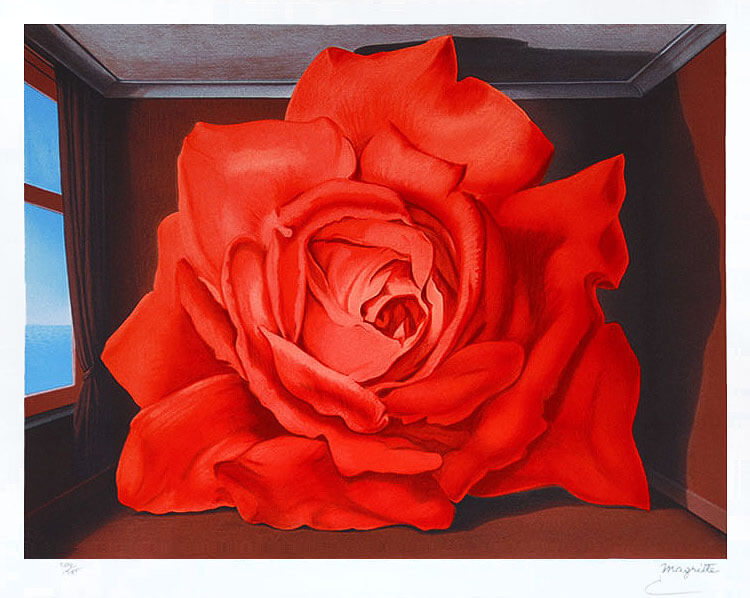“It is a tragedy, yes, but a confusing one. What happened to the wrestlers and where have they gone? Loulou the Pomeranian would love to know. Outdoors the hills are buried in snow, but inside a rose, a rose full-blown, a roomful of rose. The bloom and its shadow overtaking the space. The bloom proposing an impossible tomb. Of the Tachists, the master said to his friend Harry, “They paint white on white, and they believe that this is an achievement.” Harry said, “I dare you to paint a white rose in a white room with a window looking onto a landscape covered with snow.” Now this — which even Loulou, color-blindish, can tell is red — is the master’s grandiose response to an intoxicating challenge. Synesthetically, the rose fills Loulou’s pom ears with the echoes of torch songs, longing for the wrong. Loulou is practically drunk from the smell: a heady pink, and juicy, and almost obscene. Like crushed up candies, lingering and sweet, but with an adult musk at the core: a powerful flower. In looking, Loulou’s heart becomes a house at dusk about to force something to happen.”
– Katherine Rooney, “Le Tombeau des Lutteurs”
Katherine Rooney’s prose poem “Le Tombeau des Lutteurs” is an ekphrastic poem inspired by a painting of the same name, pictured below.

Le Tombeau des Lutteurs, or, literally, “the tomb of the wrestlers,” was painted by Rene Magritte in 1960, inspired by a conversation he had with a fellow artist named Harry Torczyner. Magritte, a Dutch artist, didn’t like the French style of Tachisim, which is a form of abstract painting comparative to surrealism (Source). As in Rooney’s poem, Magritte was quoted as saying that the Tachists “paint white on white, and they believe that this is an achievement.” In response, Torczyner challenged Magritte “to paint a white rose in a white room with a window looking onto a landscape covered with snow.” Le Tombeau des Lutteurs was Magritte’s response (Source).
The poem contains many narrative-like elements that make it seem like a scene from a story. For example, in the first few lines of the poem, Rooney introduces Loulou the Pomeranian, a character through which we see the painting. Rooney also delves into the story behind the painting, which adds more characters and even dialogue. The form of the poem, too, is prosaic; what makes this a poem, then, and not a story?
The sound of it. Rooney’s word choice makes the piece read like a true poem, especially when spoken aloud. Though there are no line breaks to highlight the rhyme, assonance, and repetition of both sound and words, they make what could be prose into poetry. The first part of the poem especially highlights this [bolded for emphasis]:
“It is a tragedy, yes, but a confusing one. What happened to the wrestlers and where have they gone? Loulou the Pomeranian would love to know. Outdoors the hills are buried in snow, but inside a rose, a rose full-blown, a roomful of rose. The bloom and its shadow overtaking the space. The bloom proposing an impossible tomb.”
The assonance continues throughout the poem, even in the direct quotes from Magritte and Torczyner, and gives the poem a richness of sound that matches the vibrancy of the painted rose. Rooney also uses a lot of elevated vocabulary, which makes the poem read almost like it’s the placard next to the painting in a museum, instead of an ekphrasis written in tribute.
The end of the poem describes the painting in terms of how Loulou reacts to it. “Synesthetically,” Rooney says, the painting makes Loulou think of the scent of a rose, almost to the point where the scent becomes real. In a similar fashion, this poem synesthetically makes the reader picture the painting without the painting needing to be there. The language Rooney uses to describe how the flower smells, how much room it takes up, and how it makes Loulou feel makes the rose real in the reader’s mind. Oddly enough, this, I suppose, is the hallmark of good art: the ability to make the viewer, the reader, the listener, or whoever, think vividly of something else.
Emma: What a wonderful post! I love this:
“The form of the poem, too, is prosaic; what makes this a poem, then, and not a story?
“The sound of it. Rooney’s word choice makes the piece read like a true poem, especially when spoken aloud. Though there are no line breaks to highlight the rhyme, assonance, and repetition of both sound and words, they make what could be prose into poetry.”